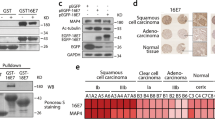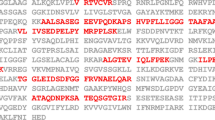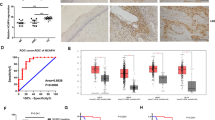Abstract
Abrogation of functional p53 is responsible for malignant cell transformation and the maintenance of malignant state of human papillomavirus-infected cancer cells. Thus, restoration of p53 has been regarded as an important strategy for molecular intervention combating papillomavirus-associated malignancies. We show here that depleting cyclin B1 stabilizes and reactivates p53 in papillomavirus-infected cervical cancer cell lines HeLa and CaSki. HeLa cells depleted of cyclin B1 exhibit mitotic defects in spindle formation and chromosome alignment. Downregulation of cyclin B1 increases p14 alternative reading frame of p16, the positive regulator of p53, and decreases phosphorylation of Ser315 in p53. Whereas RO-3306, a selective inhibitor of cyclin-dependent kinase 1 (Cdk1), suppresses this phosphorylation at Ser315 of p53, ZM447439, targeting Aurora A/B kinases, shows no effect. Further analyses in HeLa cells and HCT116 p53(−/−) cells suggest that the Ser315 phosphorylation by Cdk1 regulates negatively the protein stability and the function of p53. Moreover, increased p53 in HeLa cells is functional by showing its increased downstream effectors p21, mouse double minute 2 and Bax. Restoration of p53 and silencing cyclin B1 render cervical carcinoma cells more susceptible to DNA damage agent camptothecin. Taken together, targeting cyclin B1 might be an attractive strategy for preventing and treating papillomavirus-associated cancer by reactivating p53 and by reducing the Cdk1 activity.
This is a preview of subscription content, access via your institution
Access options
Subscribe to this journal
Receive 50 print issues and online access
$259.00 per year
only $5.18 per issue
Buy this article
- Purchase on Springer Link
- Instant access to full article PDF
Prices may be subject to local taxes which are calculated during checkout









Similar content being viewed by others
Abbreviations
- p14ARF:
-
p14 alternative reading frame of p16
- Cdk1:
-
cyclin-dependent kinase 1
- HPV 16/18:
-
human papillomavirus type 16/18
- MDM2:
-
mouse double minute 2
- shRNA:
-
small hairpin RNA
References
Androic I, Kramer A, Yan R, Rodel F, Gatje R, Kaufmann M et al. (2008). Targeting cyclin B1 inhibits proliferation and sensitizes breast cancer cells to taxol. BMC Cancer 8: 391.
Aylon Y, Oren M . (2007). Living with p53, dying of p53. Cell 130: 597–600.
Bischoff JR, Friedman PN, Marshak DR, Prives C, Beach D . (1990). Human p53 is phosphorylated by p60-cdc2 and cyclin B-cdc2. Proc Natl Acad Sci USA 87: 4766–4770.
Brown CJ, Lain S, Verma CS, Fersht AR, Lane DP . (2009). Awakening guardian angels: drugging the p53 pathway. Nat Rev Cancer 9: 862–873.
Butz K, Shahabeddin L, Geisen C, Spitkovsky D, Ullmann A, Hoppe-Seyler F . (1995). Functional p53 protein in human papillomavirus-positive cancer cells. Oncogene 10: 927–936.
Cho NH, Kang S, Hong S, An HJ, Choi YH, Jeong GB et al. (2006). Elevation of cyclin B1, active cdc2, and HuR in cervical neoplasia with human papillomavirus type 18 infection. Cancer Lett 232: 170–178.
Demidenko ZN, Blagosklonny MV . (2004). Flavopiridol induces p53 via initial inhibition of Mdm2 and p21 and, independently of p53, sensitizes apoptosis-reluctant cells to tumor necrosis factor. Cancer Res 64: 3653–3660.
Dickson MA, Schwartz GK . (2009). Development of cell-cycle inhibitors for cancer therapy. Curr Oncol 16: 36–43.
Fuchs B, Hecker D, Scheidtmann KH . (1995). Phosphorylation studies on rat p53 using the baculovirus expression system. Manipulation of the phosphorylation state with okadaic acid and influence on DNA binding. Eur J Biochem 228: 625–639.
Gallagher SJ, Kefford RF, Rizos H . (2006). The ARF tumour suppressor. Int J Biochem Cell Biol 38: 1637–1641.
Hietanen S, Lain S, Krausz E, Blattner C, Lane DP . (2000). Activation of p53 in cervical carcinoma cells by small molecules. Proc Natl Acad Sci USA 97: 8501–8506.
Katayama H, Sasai K, Kawai H, Yuan ZM, Bondaruk J, Suzuki F et al. (2004). Phosphorylation by aurora kinase A induces Mdm2-mediated destabilization and inhibition of p53. Nat Genet 36: 55–62.
Korgaonkar C, Hagen J, Tompkins V, Frazier AA, Allamargot C, Quelle FW et al. (2005). Nucleophosmin (B23) targets ARF to nucleoli and inhibits its function. Mol Cell Biol 25: 1258–1271.
Kreis NN, Sommer K, Sanhaji M, Kramer A, Matthess Y, Kaufmann M et al. (2009). Long-term downregulation of Polo-like kinase 1 increases the cyclin-dependent kinase inhibitor p21(WAF1/CIP1). Cell Cycle 8: 460–472.
Lavin MF, Gueven N . (2006). The complexity of p53 stabilization and activation. Cell Death Differ 13: 941–950.
Lu W, Chen L, Peng Y, Chen J . (2001). Activation of p53 by roscovitine-mediated suppression of MDM2 expression. Oncogene 20: 3206–3216.
Pathirana D, Hillemanns P, Petry KU, Becker N, Brockmeyer NH, Erdmann R et al. (2009). Short version of the German evidence-based guidelines for prophylactic vaccination against HPV-associated neoplasia. Vaccine 27: 4551–4559.
Pluquet O, Qu LK, Baltzis D, Koromilas AE . (2005). Endoplasmic reticulum stress accelerates p53 degradation by the cooperative actions of Hdm2 and glycogen synthase kinase 3beta. Mol Cell Biol 25: 9392–9405.
Radhakrishnan SK, Gartel AL . (2006). CDK9 phosphorylates p53 on serine residues 33, 315 and 392. Cell Cycle 5: 519–521.
Rampias T, Sasaki C, Weinberger P, Psyrri A . (2009). E6 and E7 gene silencing and transformed phenotype of human papillomavirus 16-positive oropharyngeal cancer cells. J Natl Cancer Inst 101: 412–423.
Sanhaji M, Friel CT, Kreis NN, Kramer A, Martin C, Howard J et al. (2010). Functional and spatial regulation of mitotic centromere-associated kinesin by cyclin-dependent kinase 1. Mol Cell Biol 30: 2594–2607.
Scheffner M, Huibregtse JM, Vierstra RD, Howley PM . (1993). The HPV-16 E6 and E6-AP complex functions as a ubiquitin-protein ligase in the ubiquitination of p53. Cell 75: 495–505.
Scheffner M, Werness BA, Huibregtse JM, Levine AJ, Howley PM . (1990). The E6 oncoprotein encoded by human papillomavirus types 16 and 18 promotes the degradation of p53. Cell 63: 1129–1136.
Sharpless NE . (2005). INK4a/ARF: a multifunctional tumor suppressor locus. Mutat Res 576: 22–38.
Stott FJ, Bates S, James MC, McConnell BB, Starborg M, Brookes S et al. (1998). The alternative product from the human CDKN2A locus, p14(ARF), participates in a regulatory feedback loop with p53 and MDM2. EMBO J 17: 5001–5014.
Toledo F, Wahl GM . (2006). Regulating the p53 pathway: in vitro hypotheses, in vivo veritas. Nat Rev Cancer 6: 909–923.
Vogelstein B, Lane D, Levine AJ . (2000). Surfing the p53 network. Nature 408: 307–310.
Vousden KH, Lu X . (2002). Live or let die: the cell's response to p53. Nat Rev Cancer 2: 594–604.
Wang Y, Prives C . (1995). Increased and altered DNA binding of human p53 by S and G2/M but not G1 cyclin-dependent kinases. Nature 376: 88–91.
Yuan J, Kramer A, Matthess Y, Yan R, Spankuch B, Gatje R et al. (2006). Stable gene silencing of cyclin B1 in tumor cells increases susceptibility to taxol and leads to growth arrest in vivo. Oncogene 25: 1753–1762.
Yuan J, Yan R, Kramer A, Eckerdt F, Roller M, Kaufmann M et al. (2004). Cyclin B1 depletion inhibits proliferation and induces apoptosis in human tumor cells. Oncogene 23: 5843–5852.
Zhao M, Kim YT, Yoon BS, Kim SW, Kang MH, Kim SH et al. (2006). Expression profiling of cyclin B1 and D1 in cervical carcinoma. Exp Oncol 28: 44–48.
Acknowledgements
This work is supported by the Deutsche Krebshilfe (#107594 and #108553). We are grateful to Dr B Vogelstein, Ludwig Center at Johns Hopkins, Howard Hughes Medical Institute, Baltimore, for HCT116 p53(+/+) and p53(−/−) cell lines, and Dr K Hoppe-Seyler, Deutsches Krebsforschungszentrum, Heidelberg, for CaSki cell line. We thank Ms Roth and Ms Zimmer for their excellent technical support.
Author information
Authors and Affiliations
Corresponding author
Ethics declarations
Competing interests
The authors declare no conflict of interest.
Additional information
Supplementary Information accompanies the paper on the Oncogene website
Rights and permissions
About this article
Cite this article
Kreis, N., Sanhaji, M., Krämer, A. et al. Restoration of the tumor suppressor p53 by downregulating cyclin B1 in human papillomavirus 16/18-infected cancer cells. Oncogene 29, 5591–5603 (2010). https://doi.org/10.1038/onc.2010.290
Received:
Revised:
Accepted:
Published:
Issue Date:
DOI: https://doi.org/10.1038/onc.2010.290
Keywords
This article is cited by
-
QSER1 preserves the suppressive status of the pro-apoptotic genes to prevent apoptosis
Cell Death & Differentiation (2023)
-
Circ_CEA promotes the interaction between the p53 and cyclin-dependent kinases 1 as a scaffold to inhibit the apoptosis of gastric cancer
Cell Death & Disease (2022)
-
MicroRNA-144 inhibits cell proliferation, migration and invasion in human hepatocellular carcinoma by targeting CCNB1
Cancer Cell International (2019)
-
CREPT/RPRD1B associates with Aurora B to regulate Cyclin B1 expression for accelerating the G2/M transition in gastric cancer
Cell Death & Disease (2018)
-
Deficiency of RITA results in multiple mitotic defects by affecting microtubule dynamics
Oncogene (2017)



